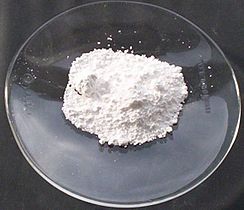- Lead(II) sulfate
-
Lead(II) sulfate  lead(II) sulfateOther names
lead(II) sulfateOther namesIdentifiers CAS number 7446-14-2 
ChemSpider 19956579 
Jmol-3D images Image 1 - [O-]S(=O)(=O)[O-].[PbH4+2]
Properties Molecular formula PbSO4 Molar mass 303.26 g/mol Appearance white solid Density 6.29 g/cm3[1] Melting point 1087 °C, 1360 K[1]
Solubility in water 4.25 mg/100 mL (25 °C) Structure Crystal structure orthorhombic, barite Thermochemistry Std enthalpy of
formation ΔfHo298–920.1 kJ/mol Standard molar
entropy So298–813.4 kJ/mol Specific heat capacity, C 103 J/degree mol Hazards EU Index 082-001-00-6 EU classification Repr. Cat. 1/3
Toxic (T)
Harmful (Xn)
Dangerous for the environment (N)R-phrases R61, R20/22, R33, R62, R50/53 S-phrases S53, S45, S60, S61 NFPA 704 Flash point Non-flammable Threshold Limit Value 0.15 mg/m3 Related compounds Other anions Lead(II) chloride, Lead(II) bromide, Lead(II) iodide, Lead(II) fluoride Other cations Tin(II) sulfate, Sodium sulfate, Copper(II) sulfate  (verify) (what is:
(verify) (what is:  /
/ ?)
?)
Except where noted otherwise, data are given for materials in their standard state (at 25 °C, 100 kPa)Infobox references Lead(II) sulfate (British English sulphate) (PbSO4) is a white crystal or powder. It is also known as fast white, milk white, sulfuric acid lead salt or anglesite.
It is often seen in the plates/electrodes of car batteries, as it is formed when the battery is discharged (when the battery is recharged, then the lead sulfate is transformed back to metallic lead and sulfuric acid on the negative terminal or lead dioxide and sulfuric acid on the positive terminal). Lead sulfate is poorly soluble in water.
Contents
Toxicology
Lead sulfate is toxic by inhalation, ingestion and skin contact. It is a cumulative poison, and repeated exposure may lead to anemia, kidney damage, eyesight damage or damage to the central nervous system (especially in children). Some lead salts may cause reproductive defects and cardiovascular disturbances. It is also corrosive - contact with the eyes can lead to severe irritation or burns. Typical threshold limit value (above which the substance is harmful) is 0.15 mg/m³.
Mineral
The naturally occurring mineral anglesite, PbSO4, occurs as an oxidation product of primary lead sulfide ore, galena.
Basic and hydrogen lead sulfates
A number of lead basic sulfates are known: PbSO4·PbO; PbSO4·2PbO; PbSO4·3PbO; PbSO4·4PbO. They are used in manufacturing of active paste for lead acid batteries. A related mineral is leadhillite, 2PbCO3·PbSO4·Pb(OH)2.
At high concentration of sulfuric acid (>80%), hydrogen lead sulfate, Pb(HSO4)2, forms.[2]
External links
- Case Studies in Environmental Medicine (CSEM): Lead Toxicity
- ToxFAQs: Lead
- National Pollutant Inventory - Lead and Lead Compounds Fact Sheet
References
- ^ a b "CRC Handbook of Chemistry and Physics", 83rd Edition, CRC Press, 2002.
- ^ Министерство образования и науки РФ, Реферат "Свинец и его свойства", 2007, http://revolution.allbest.ru/chemistry/00011389_0.html
Lead compounds Categories:- Sulfates
- Lead compounds
Wikimedia Foundation. 2010.

